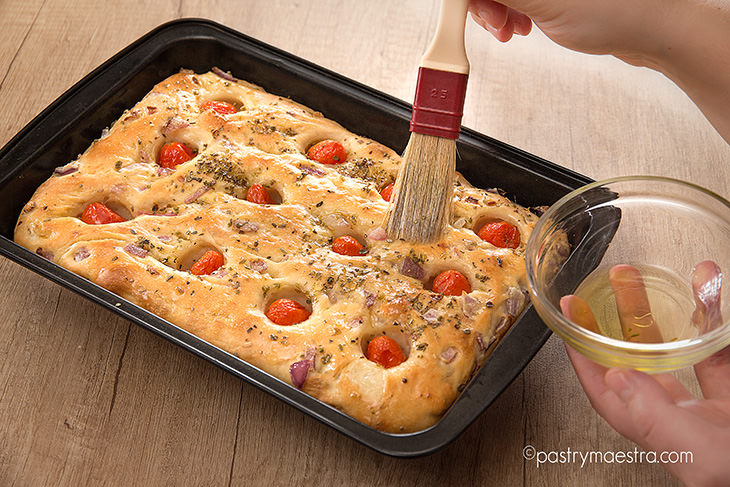F
ocaccia [foˈkattʃa] is Italian flatbread, often topped with coarse salt, olives or cherry tomatoes. Its origin goes back to the Etruscans of North Central Italy prior to the Roman Empire forming, or in Ancient Greece at the beginning of the first millennium BC. Ancient Romans, Etruscans or Ancient Greeks were baking flatbread “panis focacius” on the hearth or on a heated tile. The word focacius is derived from “focus” meaning hearth, a place for baking. Romans would mix up a simple recipe of rough flour, olive oil, water, a very small quantity of yeast, and salt, and may have been seasoned with other herbs but in most cases was probably quite plain, this was then baked in the ‘focacius’. In Roman time focaccia was used as a dipping bread, usually being torn apart by hand and dipped into salty soups made quite simply from water, vinegar, and possibly olive oil. In today’s times this doesn’t sound very appetizing but for people accustomed to long hours of physical labor it provided nourishment and was a cheap and filling meal.
The basic recipe for focaccia was brought to Francee and Spain by Romans and it became very popular bread primarily in less well off areas where the people were poor. In Spain, pan de hogaza, the peasant’s staple bread which is made in a similar way to Roman panis focacius is also known as pan rustica, a homemade bread typically made in the countryside amongst the very poor. Various versions of this Italian bread can also be found in other parts of the world. In Burgundy, focaccia is called foisse or fouaisse, in other areas of France it is known as fougasse. In Argentina, it is widely consumed under the name fugazza. The Spanish call it hogaza. There are countless variations of this dish – it seems that every village in Italy has a ‘special’ type of focaccia! The most extreme example is a specialty called focaccia col formaggio (“focaccia with cheese”) which is made in Recco, near Genoa. If the word “focaccia” wasn’t in the name of the dish, nobody would even think of it because this is in fact – a sandwich because curd and cheese filling is sandwiched between two layers of paper-thin dough!
Regarding technical details – it is mandatory to puncture the bread with a knife to relieve bubbling on the surface. Also common is the practice of dotting the bread. This creates multiple wells in the bread by using a finger or the handle of a utensil to poke the unbaked dough. As a way to preserve moisture in the bread, olive oil is then spread over the dough, by hand or with a brush prior to rising and baking. Savory versions are more familiar to general public, they can contain olive oil,tomatoes, rosemary, sage, garlic, cheese and onion, but there are also sweet recipes of focaccia containing eggs, honey, raisins, anise, sugar, and lemon or orange peel. Now – since there are countless versions of focaccia, I’ve decided to show you how to make my favorite – with cherry tomatoes, onions and oregano – I hope you’ll like it!

Focaccia Recipe
by:Tereza Alabanda,The Pastry Maestra
PRINT PDF (EN) ISPIŠI PDF (HR)Prep. time : 20 minutes
Cook time : 25 minutes
Ready in 45 minutes plus fermentation
Level : Basic
Ingredients:- Bread flour 300g (10.6oz)
- Water 170g (5.8 oz)
- Dry yeast 5g (1Tsp) or Fresh yeast 15g (1Tbsp)
- Salt 5g (1Tsp)
- Sugar 5g (1Tsp)
- Olive oil 30g (1oz)
- Onion, chopped 100g (3.5oz)
- Extra olive oil for brushing
- Optional: oregano, cherry tomatoes
- Combine water and yeast, stir until yeast dissolves.
- Put flour, salt and sugar into a bowl of a stand mixer fitted with hook attachment. Mix on a low speed and add water with yeast. Continue mixing for approximately 10 minutes until the dough becomes smooth and uniform.
- Add olive oil and mix until combined. In the end add chopped onion.
- Cover the dough and let it ferment until it doubles in size.
- Punch down the dough and flatten it into oiled 30cm x 20cm (12″ x8″) baking pan.
- Dock the dough with your fingers. Arrange cherry tomatoes on the top and sprinkle the focaccia with oregano. Let it proof for about 10 minutes before baking.
- Bake at 200ºC (400°F) for about 20-25 minutes until golden. Brush baked focaccia with some more olive oil.
Copyright© PastryMaestra.comTM
Well, what do you think about this post?
Please leave your comment on YouTube, thank you!
I read and really appreciate all the comments, even though I do not always have the time to respond to each one. So – keep me in the loop and try to create some sweetness every day because – Sweetness is happiness!!




